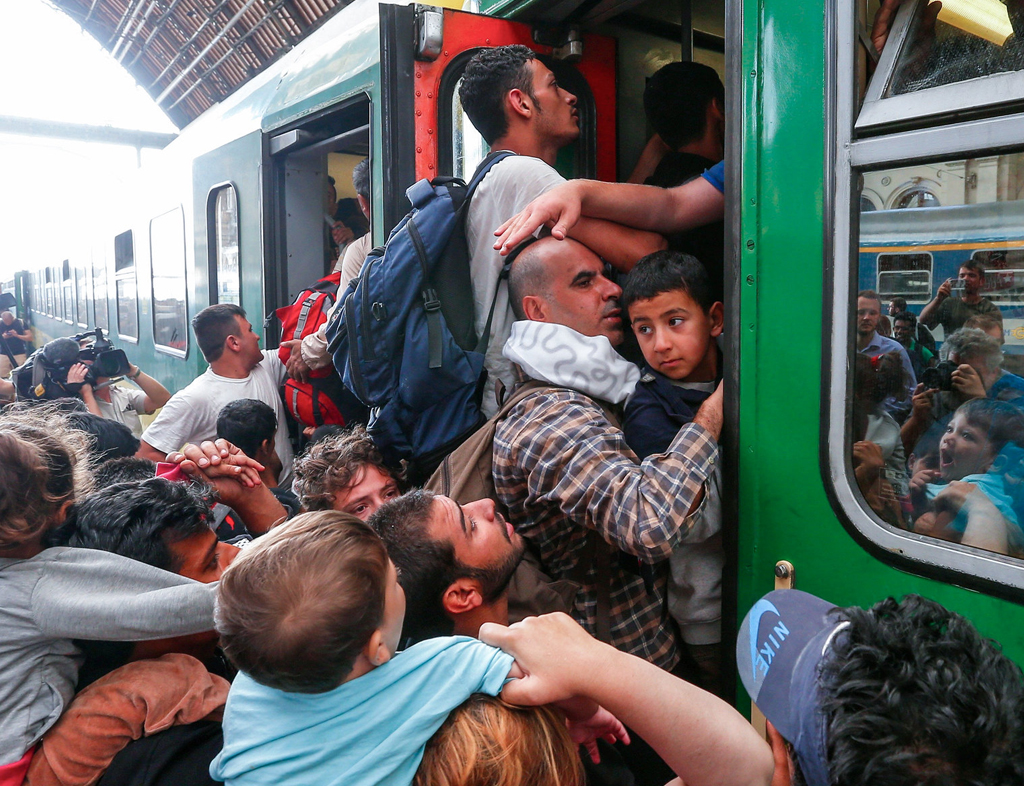To be a refugee means that you have already experienced grave assaults on your human dignity. In order to survive, a refugee must leave behind much of what defines his or her personhood. Due to conditions outside their control, refugees must leave their houses of worship, sever their community ties, and abandon their homes—and sometimes even their own families—in search of protection. The dire circumstances they flee include genocide, war, political and religious persecution, torture, and possible death. They seek immediate safety and hope that they will eventually find the opportunity to reconstitute their lives and restore their dignity.
Brutal catastrophes, resulting from violent conflict and other inhumane conditions, have not abated with globalization or new advancements in technology. Quite the contrary: According to UNHCR, the United Nations refugee agency, at the end of 2019 there were 79.5 million people forcibly displaced worldwide, including 26 million refugees and 4.2 million asylum seekers. The percentage of the world’s population that is displaced is at an historic high, with one in ninety-seven people currently displaced. Not only is the sheer number of those fleeing harm increasing, but so is the vulnerability of the populations seeking safety: Forty percent of those forcibly displaced are children. In addition, eighty-five percent of those forcibly displaced are located in the global South. Moreover, due to rising ethnic nationalism and the intensified securitization and militarization of borders, those living in exile find themselves without permanency or security.
Refugees live in a perpetual state of limbo, unable to return to their homeland and without any permanent status in another country.
Parties to the Convention Relating the Status of Refugees have an affirmative duty to not return any individual to a place where they would face persecution, and refugees are entitled to one of three sustainable solutions (UNHCR refers to them as “durable solutions”): 1) voluntary and safe repatriation to their home; 2) local integration in host communities; or 3) resettlement to a third country. Central to all three of these solutions is stability and the opportunity for refugees to reestablish their lives with a sense of autonomy and dignity. Yet, UNHCR indicates that many refugees—16 million worldwide—live in protracted situations, defined as situations in which at least 25,000 refugees from the same country have been living in exile for more than five consecutive years. These individuals live in a perpetual state of limbo, unable to return to their homeland and without any permanent status in another country. Often, generations of families live their entire lives in refugee camps, never feeling at home or finding a new place to call home. For example, approximately 2.4 million Afghan refugees have been living in protracted situations for more than forty years in Iran and Pakistan.
Resettlement: an underutilized tool
Resettlement is an underutilized sustainable solution that can provide permanent homes to refugees. Indeed, refugee resettlement is one of the durable solutions for refugees according to the UNHCR (other options include local integration and voluntary return). It provides solidity to refugees who participate in the program, allowing them to work, attend school, obtain citizenship in their new homeland, and begin to plan for the future again. In addition to providing individuals safety and the opportunity to rebuild lives, resettlement is the embodiment of nation states’ recognition of the most important canon of the UN Refugee Treaty—a state has a duty to not expel or return (“refoul”) a refugee to the “frontiers of territories” where he or she would face persecution. Due to proximity, certain nations are the first frontiers refugees cross in search of safety. Yet many of these neighboring nations are resource-poor and do not have the capacity to absorb mass influxes of refugees in the long term without the assistance of other countries.
Historically the United States was the global leader in refugee resettlement, resettling between 70,000 and 90,000 people annually. Until recently it resettled more refugees annually than all other nations combined. However, since 2017, the US government has drastically reduced the number of refugees resettled annually to 15,000. On January 27, 2017, citing security concerns, President Trump suspended the resettlement program, leaving refugees stranded in camps abroad. Those who oppose refugee resettlement often cite security as a primary concern. Yet the US resettlement program is designed carefully to vet refugees coming to this country to ensure they do not pose a danger. Refugees who are admitted through the US State Department resettlement program are subject to a thirteen-step, multi-layered, interagency security screening process.
A person wanting to harm the United States is not going to languish in a refugee camp for years and undergo an extensive background check that takes six months to several years.
First, the UNHCR must determine that a person qualifies for refugee status under international law. Then the UN must conclude that a refugee meets one of the criteria for resettlement and refer the individual case to a referral support center, contracted through the US State Department. This center gathers the refugee’s personal data and background information for security clearances. A refugee then undergoes several security clearances, including enhanced interagency security checks, all while waiting in a camp. Certain refugees then undergo another security review called a Security Advisory Opinion, which is a positive security clearance from a number of US law enforcement and intelligence agencies. A refugee is then fingerprinted and interviewed individually and in person by a Department of Homeland Security (DHS) officer.
After a refugee has been approved by DHS, he or she must undergo a medical examination and be placed with a sponsor agency that will assist upon their arrival in the United States. Prior to final departure, a refugee must clear a second interagency security check. Finally, when the refugee arrives at one of the five US airports designated for refugee admissions, a Customs and Border Patrol officer will review their documents and conduct additional security checks to ensure the arriving refugee is the same person who was screened and approved for admission to the United States abroad. A person wanting to harm the United States is not going to languish in a refugee camp for years and undergo an extensive background check that takes anywhere from six months to several years to complete.
Sharing the global responsibility to help refugees
During his US presidential campaign, Joe Biden promised to resettle 125,000 refugees to the United States annually; yet, during his first year in office, he only raised the number of refugees eligible from 15,000 to 62,500. This shift in policy only happened after criticism from advocates and members of his political party pushed back on his initial decision to keep refugee resettlement numbers at 15,000.
Considering the vast numbers of refugees worldwide, the number the United States has historically resettled annually imposes a relatively small burden upon our nation compared to the burdens absorbed by less well-resourced nations. But the benefits it brings—in terms of moral leadership, military safety, and other measures—are significant. The numbers of refugees resettled through this program is only part of its value. Resettlement sends a potent political and diplomatic message to countries facing mass influxes: Don’t shut down your border—we will help you.
This message of international burden-sharing has historical strategic significance. Notably, during the Kosovo war in 1999, Macedonia received thousands of refugees daily and during one month received more than 500,000 refugees crossing the border fleeing ethnic and religious cleansing. By March 1999, overwhelmed with a mass influx of refugees and unable to process and protect all of those fleeing, it shut its border. Concerned that if Macedonia persisted in maintaining its closed border individuals would face certain death, multiple countries, including the United States, decided to resettle a fraction of these refugees, welcoming mostly children and the elderly in make-shift camps.
Increasingly, countries are erecting barriers to refugee protection and not working together to share this global responsibility.
Agreeing to resettle some refugees signaled to Macedonia that the international community was not only able but willing to lend a hand. Simply put, Macedonia would not be the only nation responsible for the refugees’ safety and well-being. This action also sent a strong signal to Serbia that no matter how many people fled from human rights abuses, the international community collectively would provide protection. Unfortunately this example of international solidarity is an exception rather than a norm. Increasingly, countries are erecting barriers to refugee protection and not working together to collectively share this global responsibility.
Granted, refugee resettlement is not a panacea for the global protracted refugee problem. Yet it is a vital tool, establishing that refugees in search of protection are the collective responsibility of the international community and that countries are committed to solutions promoting human flourishing and integral human development.
Erin B. Corcoran is associate teaching professor in the Keough School of Global Affairs and executive director of the Kroc Institute for International Peace Studies. Corcoran’s work focuses on immigration and refugee law, human rights law, and other complex legal topics at the national and local level.
This article is part of a series of blog posts published by the Keough School of Global Affairs. Dignity and Development provides in-depth analysis of global challenges through the lens of integral human development.


